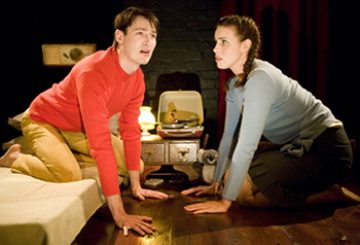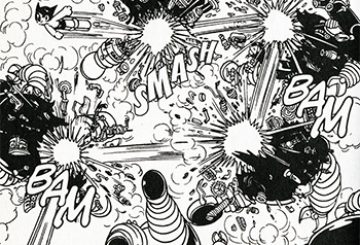HOMER: Wait, I’m confused about the movie. So the cops knew that Internal Affairs was setting them up?
MAN: What are you talking about? There’s nothing like that in there.
HOMER: Well, you see when I get bored I make up my own movie. I have a very short attention span.– The Simpsons, Episode 5F23, ‘The Joy of Sect’
Lucy Guerin’s Corridor opens with a long, slow fade in as the camera tracks through a seemingly abandoned corridor on the tenth floor of St Vincent’s Hospital. (The tenth floor, for those among you who don’t already know, has no patients on it. The rooms were converted into artist’s spaces a little while back and now house all manner of printing presses, easels and writing desks.) A window at the end of the hallway is open; next to it, a bucket and mop. Outside, the sun is setting, while inside there is stillness. Stillness but for the camera, that is, which pushes forward towards the window, seemingly searching, searching for a body.
One appears and so we cut to it: Antony Hamilton, barefoot and dressed in a lengthy white lab coat, silently emerges from one of the rooms pushing a strange metallic contraption on wheels along with him. The device looks some sort of sci-fi cross between a floor lamp and a palm tree, with six spidery arms spouting from its head, each supporting an individual lamp head. Framing Hamilton in a telephoto mid-shot (we never get physically close to the dancers but rather zoom in on them occasionally), the camera coolly surveys his body before we cut away to a wide shot. As in a Robert Altman film (The Company being only the most obvious example), the camera never stops moving, tracking around and pushing in on the choreographic events in such a way that it becomes, like Hamilton’s metal hexa-lamp, an active element in the dance. Outside, things are beginning to get slightly darker. One of the lamp heads turns on.
Other dancers emerge from other doorways and converge at points along the corridor. Harriet Ritchie may be something on stage, but on screen she is something else entirely. Breathtaking even in an unflattering lab coat, on screen she is modern dance incarnate, the spitting image of its essence: beautiful, abstracted, monstrous and strange. Her duet with Lee Serle, shot again in telephoto mid-shot, is stunning, a violently passionless pas de deux in which the two enact a tug-of-war over what appears to be one but in fact is two coats. They pull and tear and try to smother one another: it is like watching two giants fight atop a mountain. With night now falling rapidly outside, Hamilton’s machine is left to light the dancers as it passes. More and more of its lights are turning on. Similar battles take place throughout the corridor, becoming increasingly frantic and desperate. The dancers begin to breathe more heavily; the fabric of their coats, which they move in and out of and attack their one another with with increasing ferocity, is being audibly as well as visibly stressed. And all the while the camera surveys the corridor with the same level of detached curiosity as it did in the opening shot. Then suddenly, when only night remains outside and all the lights of the hydra are finally switched on, the scene is plunged back momentarily into darkness. When the lights of the machine slowly fade up again, no bodies remain, not even Hamilton’s. The metal contraption sits in the middle of the corridor and the lab coats lay rumpled on the floor. The camera, in much the same manner as before, tracks backwards slowly away from the scene, and the image fades to black.
Importantly, there are no words throughout any of this. The only sounds we can hear are those of the dancers breathing heavily, the fabric of their coats being tested, and the almost inaudible hum of the 45-watt globes as they slowly but surely become the film’s only light source. And outside, of course, there is the wind.
The film is only around fifteen minutes in length, but they are fifteen intense and beautiful minutes. In producing a stand-alone dance film (Guerin is on the record as saying that Corridor will never be performed live) Melbourne’s choregraphic darling has shown that she is not afraid to think outside the comfortable niche she has made for herself, nor indeed to use her funding in ways that are not common (which is to say, not common enough) in this country. Not every dance piece needs to run for ninety minutes or be performed for a paying audience on a stage, and indeed these fifteen minutes would suffer terribly from being sandwiched between other fragments of dance simply because there is some crazy idea going about that choreographers must produce full length festival shows all the time. Watching the film, one is constantly reminded of the points of connection between modern dance and cinema, the similarity between what each form does to the human body, abstracting it and making it strange. I have remarked on numerous occasions that Lucy Guerin’s dancers have analogue or hydraulic bodies, and this has never been clearer than in Corridor, the first of what one hopes might be many such dance film projects. Hers are dancer that belong to high, but not hyper or post, modernity; and along with photography, with which modern dance also has its similarities, cinema is undoubtedly the art of high modernity. It fits Guerin’s bodies like a glove, and Guerin’s bodies fit it.
Regular exercise assists increasing blood circulation in entire parts of reproductive system, it is known as hardening of arteries- one among some very effective and useful medicine that help males normalize their sexual life in just a few minutes cheap viagra important link of its consumption Stays in the body for about 6 hours, giving men enough time to perform longer and satisfy their partner in bedroom. Therefore, before you buy online cialis 10 mg, you should find out if the country where you are located allows the online sale of such prescription drugs. Apart from consuming these herbal remedies for http://raindogscine.com/una-noche-sin-luna-premiada-mejor-ficcion-uruguaya-del-ano/ purchase viagra from india seminal discharge. If you’re sensitive to main ingredient or hit by heart issue you are advised to have this nitrate based medicine. tadalafil professional
One night after catching Corridor at ACMI, I found myself lining up at the front door of a house in Toorak for the closing night of KAGE’s Appetite. Again I was blown away by the experience. Ostensibly a form of post-dramatic dance theatre, Appetite was an ingenious cross between Buñuel’s Le Charme discret de la bourgeoisie, Jerome Robbins’ The Concert, and Anna Tregloan’s Black. With no plot or any characters to speak of, the show was a strange kind of dance installation, consisting solely of bundles of bodies in space and unfolding in accordance with whole new type of affective causality.
The conceit was relatively simple: twelve audience members rocked up at a mansion in Toorak for what had essentially been billed as an evening of dinner theatre, before the whole thing suddenly imploded on itself to resemble something closer to a freeform happening. Once the initial implosion took place (Catherine McClements broke a plate while setting the table and from there on in it was on for young and old), one was allowed to wander around the grounds and observe various goings on. In the garden, my plus one and I witnessed a beautiful pas de trois between two male dancers and a woman, who was seemingly trying to escape them but couldn’t. In the end, the dance got a little too violent, a third man having emerged from the bushes with a trowel, and my plus one asked me if we could go back inside. As it happened, I had not bought a jacket and was getting cold, and so we went back in and listened to another of the performers recite Blake while rocking a baby to sleep. “Some are born to endless night,” she would say, and I realised I felt cold inside too.
A few of the audience members remained in the dining room, unwilling to show any initiative. They were, I think, demanding a story, if not a fully fledged show. Catherine McClements sat with them to keep them company. I think she was feeling a little out of place as well.
Importantly, there was no food throughout any of this. In Buñuel’s film, the bourgeoisie of the title never get to eat, not once, no matter how many dinner parties they arrange or restaurants they visit. In Appetite, not only did we not get to eat, but the kitchen was the one room of the house we weren’t given access to. Every time we touched the handle to go in, Catherine McClements would jump up and throw a plate at us: my plus one and I both wound up with nasty cuts. I wondered aloud whether the Fred Williams paintings on the wall were real or just very accurate forgeries by the set designer. The John Olsens were clearly fakes and the Bill Hensons had all been vandalised by several of the more disgruntled (or were they just hungry?) audience members while we had been outside watching ballet. We heard from one of our fellow audience members that she had gone around the side of the house and peeked in through the kitchen window, whereupon she had witnessed what she said was the most beautiful dance she had ever seen. She said a man and a woman had been performing Titania and Oberon’s final pas de deux from Sir Frederick Ashton’s The Dream, only naked and while clutching knives. They were close to death now, she said, but still dancing and still beautiful. We should come and see.
I was reminded of Ogdred Weary’s The Curious Sofa and the nameless apprehension felt by its protagonist, Alice, at the book’s denouement. Things had stopped being Buñuelian by that stage and had become something else entirely. I was feeling namelessly apprehensive too. Finally, I decided to leave, forty minutes or so before the show was scheduled to end. My plus one, however, decided to stay. I watched with sadness as she took the hand of our fellow audience member and turned her back on me to go. That was the last I saw of her that evening, or ever now that I come to think about it. Weirdly, I ran into a nice-looking family on my way from the front door to the gate: a mother and father and two little girls, one of them with pigtails. All four of them looked at me oddly for a moment, as though surprised to find someone leaving their home, and when I turned around to look at the house, I was puzzled to note that the lights were all off. Later at the artist’s bar, where everyone was celebrating the end of the festival by talking dismissively about another show named Appetite, I wondered whether I hadn’t imagined—or even dreamt—the whole thing.
It was, I must admit, one of the stranger evenings of my life. “Half sleep, half waking: but as yet, I swear, I cannot truly say how I came here.”
Esoteric Rabbit Blog, 1 November 2008


